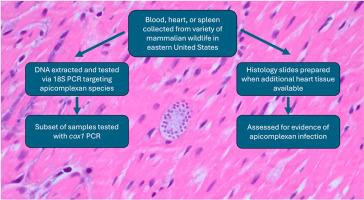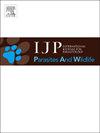Survey for Babesia spp. in wildlife in the eastern United States
IF 2.2
3区 医学
Q3 ECOLOGY
International Journal for Parasitology-Parasites and Wildlife
Pub Date : 2024-11-01
DOI:10.1016/j.ijppaw.2024.101015
引用次数: 0
Abstract
Babesia is a diverse genus of piroplasms that parasitize the red blood cells of a wide variety of mammals and avian species, including humans. There is a lack of knowledge on the Babesia species of carnivores and mesomammals in the eastern United States and the potential impacts of these species on the health of humans and domestic animals. We surveyed 786 wild mammals in the eastern United States by testing blood, spleen, and heart samples with PCR targeting the 18S rRNA region of apicomplexan parasites. We also performed PCR targeting the cytochrome c oxidase subunit 1 (cox1) region of each unique clade identified with 18S rRNA sequencing. We found a high positivity of Babesia spp. infection in raccoons (Procyon lotor), foxes (Vulpes vulpes and Urocyon cinereoargenteus), and striped skunks (Mephitis mephitis), and low positivity in Virginia opossums (Didelphis virginiana). No Babesia infections were detected in coyotes (Canis latrans), black bears (Ursus americanus), groundhogs (Marmota monax), muskrats (Ondatra zibethicus), or mink (Neovison vison). Skunks carried a diverse number of strains including a potential novel species of Babesia related to B. gibsoni, a strain closely related to a B. microti-like species known to cause disease in river otters, as well as a separate B. microti-like strain. Raccoons primarily carried B. microti-like strains, though there was a high diversity of sequences including Babesia lotori, Babesia sensu stricto MA230, and Babesia sp. ‘Coco.’ Foxes exclusively carried B. vulpes. In addition to Babesia spp., a high positivity of Hepatozoon spp. infection was found in mink, while low positivity was found in raccoons and muskrats. Wildlife in the eastern United States carry a diverse range of Babesia species including several novel strains of unknown clinical significance.

美国东部野生动物巴贝西亚原虫调查
巴贝西亚原虫(Babesia)是一种寄生在包括人类在内的多种哺乳动物和鸟类红细胞内的多种多样的螺旋体属。人们对美国东部食肉动物和中型哺乳动物的巴贝西亚原虫种类以及这些种类对人类和家畜健康的潜在影响缺乏了解。我们对美国东部的 786 种野生哺乳动物进行了调查,用针对 apicomplexan 寄生虫 18S rRNA 区域的 PCR 对血液、脾脏和心脏样本进行了检测。我们还对通过 18S rRNA 测序确定的每个独特支系的细胞色素 c 氧化酶亚基 1(cox1)区域进行了 PCR 检测。我们发现浣熊(Procyon lotor)、狐狸(Vulpes vulpes and Urocyon cinereoargenteus)和条纹鼬(Mephitis mephitis)感染巴贝西亚原虫的阳性率较高,而弗吉尼亚负鼠(Didelphis virginiana)的阳性率较低。郊狼(Canis latrans)、黑熊(Ursus americanus)、土拨鼠(Marmota monax)、麝鼠(Ondatra zibethicus)或水貂(Neovison vison)均未检出巴贝西亚原虫感染。臭鼬携带的菌株多种多样,包括一种与 B. gibsoni 相关的潜在新型巴贝西亚菌株、一种与已知在河獭中致病的类似 B. microti 的菌株密切相关的菌株,以及一种单独的类似 B. microti 的菌株。浣熊主要携带 B. microti-like菌株,但序列的多样性很高,包括 Lotori巴贝西亚原虫、严格意义上的巴贝西亚原虫 MA230 和 'Coco' 巴贝西亚原虫。狐狸只携带秃头巴贝西亚原虫。除了巴贝西亚原虫外,水貂也发现了肝吸虫属感染的高阳性率,而浣熊和麝鼠的阳性率较低。美国东部的野生动物携带多种巴贝西亚原虫,包括几种临床意义不明的新型菌株。
本文章由计算机程序翻译,如有差异,请以英文原文为准。
求助全文
约1分钟内获得全文
求助全文
来源期刊

International Journal for Parasitology-Parasites and Wildlife
Medicine-Infectious Diseases
CiteScore
3.80
自引率
5.60%
发文量
113
审稿时长
45 days
期刊介绍:
The International Journal for Parasitology: Parasites and Wildlife (IJP-PAW) publishes the results of original research on parasites of all wildlife, invertebrate and vertebrate. This includes free-ranging, wild populations, as well as captive wildlife, semi-domesticated species (e.g. reindeer) and farmed populations of recently domesticated or wild-captured species (e.g. cultured fishes). Articles on all aspects of wildlife parasitology are welcomed including taxonomy, biodiversity and distribution, ecology and epidemiology, population biology and host-parasite relationships. The impact of parasites on the health and conservation of wildlife is seen as an important area covered by the journal especially the potential role of environmental factors, for example climate. Also important to the journal is ''one health'' and the nature of interactions between wildlife, people and domestic animals, including disease emergence and zoonoses.
 求助内容:
求助内容: 应助结果提醒方式:
应助结果提醒方式:


